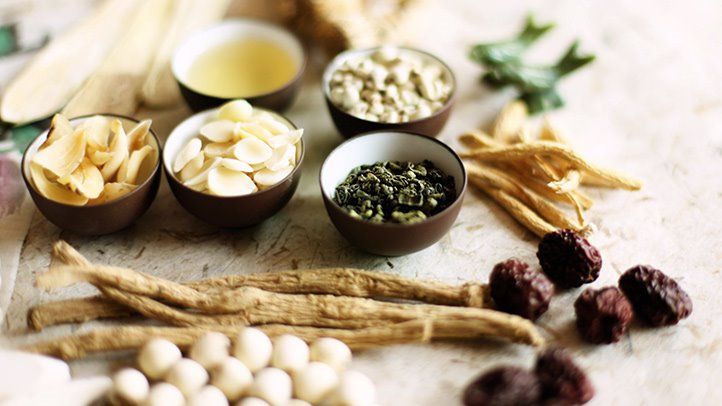Chinese herbal medicine (CHM) has been used in the treatment of endometriosis, a condition characterized by the presence of endometrial tissue outside the uterus, which can cause pain and infertility. The use of CHM for endometriosis is based on traditional practices and has been a subject of research to evaluate its efficacy.
A Cochrane review from 2012 suggests that oral CHM may have a better overall treatment effect than danazol, a hormonal drug used to treat endometriosis, and may be more effective in relieving dysmenorrhea (painful periods) and shrinking adnexal masses associated with the condition.
The review also indicates that post-surgical administration of CHM may have comparable benefits to gestrinone, another hormonal treatment, and that CHM appears to have fewer side effects than either gestrinone or danazol. However, the review emphasizes the need for more rigorous research to accurately assess the potential role of CHM in treating endometriosis.
The specific use of Chinese herbal enemas, in combination with oral CHM, has been mentioned in research as a method to treat endometriosis symptoms. The herbs used in these treatments are considered to be “blood moving” in Chinese medicine and are thought to help regulate pelvic blood flow, modulate immune system activity, and reduce inflammation.
It is important to note that while there is some evidence supporting the use of CHM for endometriosis, the quality of the studies is limited, and more high-quality randomized controlled trials are needed to confirm the effectiveness of these treatments.
Additionally, the exact prescription patterns and formulations of CHM can vary widely, which may affect the outcomes and reproducibility of the studies.

The active ingredients in Chinese herbal medicine for endometriosis vary depending on the specific herbal formula used. Here are some active compounds identified in various studies:
- Corydalis rhizome extract: Contains tetrahydropalamatine, which is used in many Chinese formulas for treating endometriosis[1].
- Guizhi Fuling Pills: This prescription is composed of Cassia Twig, Poria Cocos, Peach Kernel, and other herbs. The main active compounds include pachymic acid, cinnamaldehyde, amygdaloside, and paeoniflorin[2].
- Qu’s formula (QUF): A patented Chinese herbal medicine consisting of Common Lophatherum, Radix Paeoniae Rubra, Curcumae Rhizoma, and Radix Bupleuri. These herbs contain various compounds that contribute to their therapeutic effects[3].
- Polyphenolic compounds, sesquiterpenes, terpenoids, flavonoids, alkaloids, polysaccharides, and steroid glycosides: These are commonly found in herbs used for treating endometriosis in Chinese medicine[4].
- Gui-Zhi-Fu-Ling-Wan: Contains ingredients like cinnamon twig and poria, which have sedative and anti-inflammatory properties.
These active ingredients are believed to work by regulating pelvic blood flow, modulating immune system activity, reducing inflammation, and potentially affecting estrogen levels. However, the exact mechanisms of action and the efficacy of these compounds in treating endometriosis require further research. It is also important to note that the effectiveness of these ingredients can depend on the specific formulation and the individual patient.
Chinese herbal enemas
Chinese herbal enemas for the treatment of endometriosis utilize a variety of active ingredients, depending on the specific formulation. Here are some active ingredients identified in various studies:
- Common Burreed Tuber, Red Peony Root, Aeruginous Turmeric Rhizome, Turmeric Root Tuber, Peach Seed, Degelatined Deer-horn, Malaytea Scurfpea Fruit, Cassia Twig, Ground Beetle, Inner Membrane of Chicken Gizzard: These ingredients were used in a Chinese herbal enema treatment for endometriosis, which was found to have a high clinical effective rate.
- Spina Gleditsiae, Rhizoma Curcumae, Rhizoma Corydalis, Caulis Sargentodoxae, Rhizoma Cimicifugae, Herba speranskiae tuberculatae: These are the active ingredients in a patented Chinese herbal enema for treating endometriosis.
- Nei Yi Wan: This is a traditional Chinese herbal mixture used both orally and via enema to treat endometriosis. The specific active ingredients are not mentioned, but the herbs are considered “blood moving” in Chinese medicine, which may help regulate pelvic blood flow, modulate immune system activity, and reduce inflammation.
- Sanjie Zhentong: This Chinese herbal formula has been shown to be effective in reducing endometriosis pain and reducing inflammatory markers[8].
Here is a step-by-step guide on how to use a CHM enema:
- Preparation of the Enema: The specific herbs used in the enema will depend on the prescription given by a healthcare professional knowledgeable in CHM. The herbs are typically boiled in water to create a decoction, which is then cooled before use.
- Positioning: The patient should lie on their left side with their right knee flexed. This is known as the Sims’ position and is commonly used for enema administration.
- Administration: The enema is administered using a rubber cannula or similar device. The cannula is gently inserted into the rectum, and the herbal decoction is slowly introduced. The patient should try to retain the enema for as long as possible to allow the herbs to be absorbed.
- Frequency: The frequency of enema administration will depend on the specific prescription, but it could be administered daily or several times a week[8].
- Follow-Up: The patient should monitor their symptoms and report any changes to their healthcare provider. This will help assess the effectiveness of the treatment and adjust the prescription if necessary.
It’s important to note that while there is evidence suggesting potential benefits of CHM for endometriosis, more high-quality randomized controlled trials are needed to confirm the effectiveness and safety of these treatments. Always consult with healthcare professionals knowledgeable in both conventional and traditional medicine before starting any new treatment regimen.

